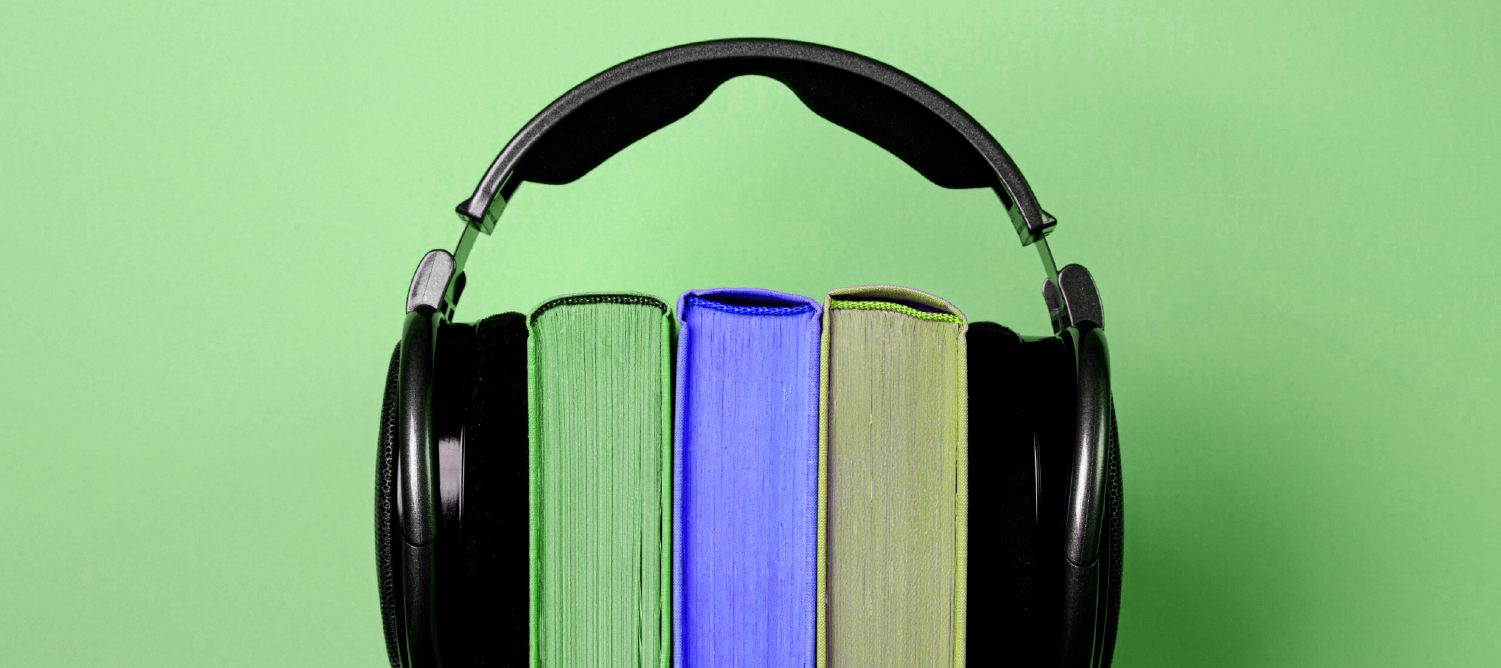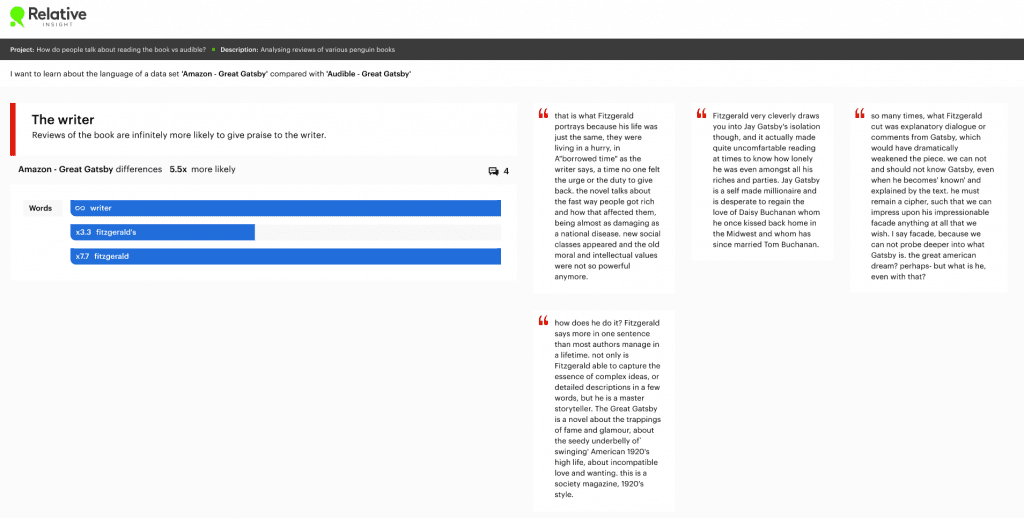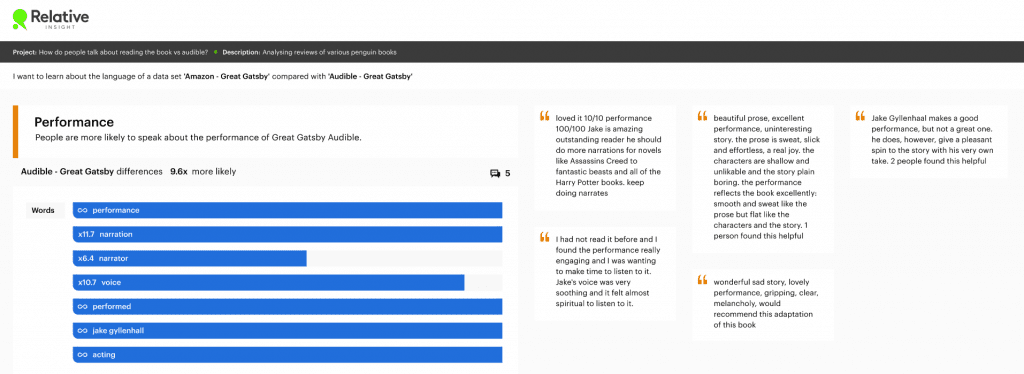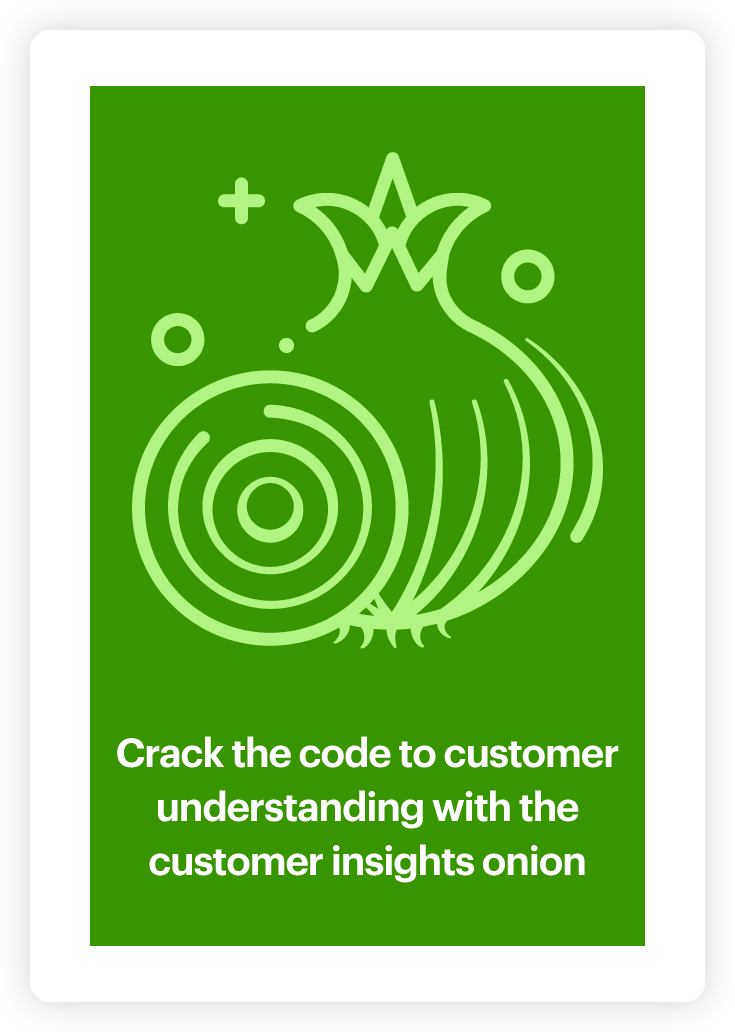Reading vs. audiobooks: Analyzing reviews of The Great Gatsby

For many people, reading a book is one of life’s simplest pleasures. Page by page we fall deeper into a story; we’re whisked away into another world and transported to another time.
However, the reality is that lots of us lack the time to actually get stuck into a new book. With brimming schedules and busy lives, we’re increasingly relying on audiobooks as a convenient substitute for reading.
But is it better to read or listen to a book? Moreover, how do our opinions and thoughts about a story fluctuate if we experience a story through different mediums? To find out, we turned to comparison.
Taking F. Scott Fitzgerald’s 1925 classic, The Great Gatsby, we used Relative Insight to analyze Amazon reviews of the novel and the respective Audible reviews, to create the comparison: reading vs listening.
Relative Insight uses text analysis to analyze and compare qualitative data, leveraging comparison to pinpoint the differences in words, phrases, grammar, topic and emotion that are more prevalent in one data set over another. This form of consumer insight analysis enables us to highlight the differences in how people talk about reading vs. audiobooks and discover key customer insights about readers and listeners.
Reading the novel
Throughout our reading vs. audiobooks analysis, we found that readers of the novel were 5.5x more likely to talk about the author, F. Scott Fitzgerald. The word writer appeared infinitely more in this data set, suggesting that listeners of the audiobook did not associate the novel with something that was indeed written. This could suggest that readers tend to feel more connected with the writer and his words than listeners, and therefore feel a bigger need to give literary praise in their reviews.

Another key insight was this idea that readers are positioned as a collective. Book reviews of The Great Gatsby were 6.8x more likely to include the first-person plural pronoun we, in comparison to Audible reviews. It is not the lone reader who meets Nick Carraway on the first page of the novel, but “we meet Nick Caraway”, “we have shared something significant, elemental and proud”. We refers to every person who has and will read this classic during their lifetime and highlights the shared experiences the come with reading a book.

Relative Insight’s emotional text analysis revealed that fear and shock were 8.7x more likely to appear in book reviews of The Great Gatsby, when compared to the audiobook. This was often in the context of readers returning to the novel second time and feeling surprised by its contents as well as their subsequent reaction. This is an important audience insight which suggests that readers are more likely to draw different conclusions each time they come back to the novel, suggesting a constantly changing and evolving relationship with Fitzgerald’s prose.
Listening to the audiobook
So, what can we draw from the Audible reviews of The Great Gatsby?
As can be expected, Audible reviews of The Great Gatsby were 3x more likely to mention ease. Instead of finding time to sit down and read the entire novel, audiobooks enable people to go about their day while simultaneously listening to a story – which is clearly an important point in the reading vs audiobooks debate.
However, what’s interesting is that listeners were 9.6x more likely to speak about the performance elements of the audiobook adaptation. Reviewers discussed narration, acting, the voice of the narrator implying that the Audible version was seen as more than just reading the story aloud or as the easy option. The word experience appeared more in this data set, highlighting the idea that audible adds another layer to the story and enriches the book in more ways than one.

Similarly, people who listened to the Audible version of The Great Gatsby were 4.1x more likely to use emotive language. Words such as cry, emotional, enjoyed and moved show how listeners reacted to the audiobook version. Again, this emphasizes the idea that hearing the words spoken breathes life into the book, like watching a film adaptation. For publishers, this is a powerful insight which they could leverage when promoting new audible adaptations.

Customer insights examples like these give us a deeper understanding of two distinct audiences – the reader and the listener. The unique reading vs. audiobooks insights which were surfaced highlight how either reading a novel or listening to an audiobook can impact a person’s experience of a story. It enables publishers to gain a better awareness of what each audience is looking for and presents them with the opportunity to monitor people’s reactions to new releases.
